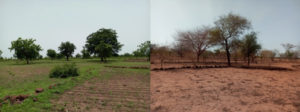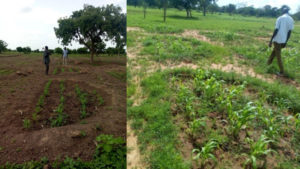In this series, we’re sitting down with the Swette Center affiliated faculty to catch up on food systems, innovation, and what makes a good meal. See the rest of the series on our Food Systems Profiles page.
Read on for an interview with Elisabeth llboudo Nébié, assistant professor at the School of Human Evolution and Social Change.
1) How did you get interested in food systems issues?
I was born and raised in a semi-arid country where food insecurity is a major problem in many families, especially in rural areas when a drought hits. As a child, I spent lots of time in the village with my siblings, cousins, and grandparents in the summer. Even though my immediate family did not experience food insecurity, seeing people around us who could not afford a meal has shaped my interest in food systems research. Most of my work in BF (Burkina Faso) has focused on pastoralism because I had the opportunity to work with the International Livestock Research Institute (a CGIAR center) as a doctoral student. It is really cool working in this field because my dad was a veterinarian who worked with some of the livestock owners I had the chance to work with. He passed away when I was 10, and it feels great to pursue the work he was involved in differently.
2) Share a glimpse of your current research and how it applies to food systems transformation.
I am working on many different research projects, but I can share one of them.
I am currently documenting, comparing, and contrasting successful climate adaptation strategies that farmers and herders use to adapt to environmental changes, namely land degradation and rainfall variability across the Sahel region of West Africa. These include soil and water conservation techniques that I will show you shortly.
SWC has a long history within the Sahel, dating back to the 1930s when colonial powers became interested in addressing land degradation and its impacts on agricultural productivity. Most conservation projects from the 1930s through the 1970s were using top-down approaches. They involved government extension agents who were trained by western experts who then passed on their knowledge to rural farmers. In the 1970s-80s, this paradigm started shifting away because the succession of extreme weather events such as droughts and subsequent food insecurity prompted farmers and international organizations (especially non-profits) to promote indigenous conservation technologies to manage the consequences of land degradation, desertification, and drought in the Sahel. Different projects and indigenous SWC types were studied & have been widely documented (IFAD 2011; Kpadonou et al. 2017; Partey et al. 2018; Wolka 2018). The most prominent and oldest ones throughout the Sahel include the Zai planting pits technology, contour stone bunds, vegetative barriers, half-moons (Nyamekye et al., 2018), and farmer-managed natural regeneration (Weston et al., 2015).
These pictures were taken in 2021 by my research assistant Yogo Perenne in the central region of Burkina Faso (BF).



3) What’s an innovation in the food systems world that you’re excited about?
I already told you about soil and water conservation (SWC) strategies – which I am excited about, of course, but since I work a lot with pastoralists, I also like shedding light on some of their innovations that we do not really talk about much. Pastoralist communities are less studied –one commonly given reason is that these communities are often mobile and harder to get in touch with– & sometimes marginalized (i.e., migrant status in most of the communities they move into) compared to agricultural communities. Even when studied, they are often included under the general umbrella of “agriculture,” even though herders face particular challenges with livestock that agriculturalists might not with crops. Pastoralists take longer to recover from droughts than farmers, and they are more affected in terms of food insecurity: Violent conflict exacerbated drought-related food insecurity between 2009 and 2019 in sub-Saharan Africa (I am one of the authors on this paper).
I am very excited about fodder cropping in pastoralist communities. With global environmental and social changes, herders are being pushed to sedentarize, making crop growing the new normal for many. Even though the positive aspects of mobility have been widely documented (i.e., pastoralists are known to be more resilient in times of rainfall variability when they can move livestock from dry to humid areas), this push for sedentarization still persists. In BF, the government is pushing herders to become sedentary because mobility has been linked with farmer-herder conflicts when livestock enter agricultural fields, among other issues.
So it is important for herders to learn to adapt to their new sedentary or semi-sedentary lifestyle. Growing crops is very new for the herders I work with because, traditionally, they do not farm. They only raised livestock and moved in it from dry to humid areas. But now, they must grow fodder crops to ensure they can survive along with their livestock while moving less.
Contrary to what one would think, in the communities where I work, people have welcomed fodder cropping as the new normal. They are even asking for help to grow more in order to survive life in their pastoral zone (the place where the government resettled them). So far, the fodder grown is kept to feed livestock in the dry season when they cannot move. In addition to storing this fodder on trees, pastoralists have found new ways of storing this fodder in order to keep it nutritious and away from the elements (sun, wind, humidity) and theft. Many are investing in what is known as “fénils,” which are haylofts with a door that can be locked. So far, cultivated fodder can be shared among pastoralist households in times of food insecurity, but it is not sold among pastoralists.
These pictures show how housing in the pastoral look like. Fénils are really different and show how much importance herders give to livestock food security.

4) What’s your favorite weeknight meal?
I am a big fan of African food. I love eating steamed cassava semolina, known in West Africa as “attiéké,” with fish or grilled chicken and a side of plantains, onions, tomatoes, and a little bit of spicy sauce...it is delicious and very easy to make.
Attiéké is made of fermented cassava and originated from Ivory Coast. But today, this meal traveled beyond the borders of the Ivory Coast across West Africa and its diaspora. It is a bit heavy as a weeknight meal, but I love it! It is also a very popular street food where I grew up in BF, so every time I go back home or whenever I find a West African restaurant, that is what I order most of the time.
Attiéké is commonly processed by women and women groups. Since we are talking about resilience and food insecurity, there is an article (click here) I would like to share with you about the cassava and cassava-based foods crisis due to the non-adoption of improved cassava varieties by Attiéké women. The improved varieties have shorter cycles which reduces land tenure issues because the cassava grows faster, and landowners can get back their land more quickly from producers. Attiéké women producers in the Abidjan area are reluctant to adopt these improved cassava varieties because local knowledge about production is transferred from generation to generation with the idea that good quality attiéké has to be made from traditional varieties. This issue between science & local knowledge clearly has an impact on food security and deserves to be further studied.
